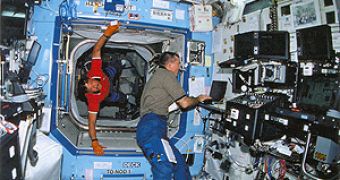NASA confirmed, at a recent space operations meeting (ISS 30P SORR), that a worm had been discovered on laptops on the International Space Station. Even if NASA has not disclosed its name, the malware in question appears to be W32.Gammima.AG and it spreads by copying itself to removable devices. The NASA officials note, however, that this is not the first time malware makes its way onto the station.
The worm infected more than one laptop on the station and, while an investigation is underway to determine how the malware infected the equipment, given the spreading methods of W32.Gammima.AG, it’s likely that a flash memory device is responsible for the propagation. As for the initial source of infection, there are a few possibilities.
The worm could have been brought in from the surface along with the equipment, but according to NASA spokesperson Kelly Humphries, all such equipment undergoes serious scanning. "Everything is scanned before it goes up, so it's an indirect connection," Humphries said. Also according to Humphries, most of the equipment is bought by the US or by Russia.
The International Space Station does not benefit from a direct connection to the Internet, but there is a KU band link used for video, audio and other data transfers. The astronauts can also use this link to send and receive e-mails, while the report notes that many laptops do not have any antivirus software installed.
The W32.Gammina.AG is not a high-risk worm, its main function being to steal online gaming accounts information. It spreads using local drives and removable storage devices and is fairly easy to remove. According to NASA, the infected laptops are only used for e-mail or nutritional experiments, but Humphries evaded to say if they were connected to mission-critical equipment, pointing out that "I don't know and even if I did, I wouldn't be able to tell you for IT security reasons."
Given that this is not the first time such an event occurs, Mr. Humphries pointing out that "it's not a frequent occurrence, but this isn't the first time," NASA and its international partners are working on finding solutions to prevent this from happening in the future. One focus is on the implementation of more strict procedures regarding checking the equipment on the ground before it’s flown up.

 14 DAY TRIAL //
14 DAY TRIAL //